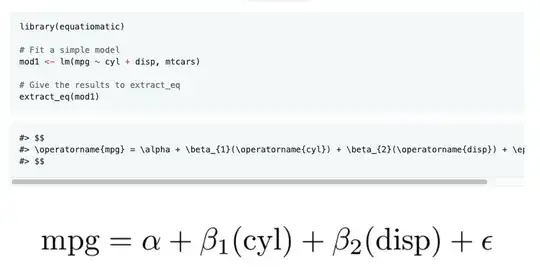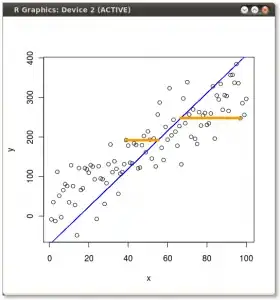We can use lm() to predict a value, but we still need the equation of the result formula in some cases. For example, add the equation to plots.
- 132,789
- 81
- 357
- 650
- 359
- 1
- 3
- 4
-
3Can you please rephrase your question or add some details? I'm quite familiar with R, `lm` and linear models more generally, but it's not at all clear what, exactly, you want. Can you give an example or something to clarify? Is this for some subject? – Glen_b Jul 08 '13 at 03:27
-
2I guess you want the coefficients of the linear regression formula. Try calling `coef()` on the fitted `lm` object, as in: `mod – Jake Westfall Jul 08 '13 at 03:36
-
If you type `lm(y~x)$call` it tells you the formula is `y ~ x`. If you mean something different from that, you need to be more specific. – Glen_b Jul 08 '13 at 06:47
-
1Related: [How to apply coefficient term for factors and interactive terms in a linear equation?](http://stats.stackexchange.com/q/24242/930) – chl Jul 08 '13 at 11:26
-
1Worth reading http://stackoverflow.com/questions/7549694/ggplot2-adding-regression-line-equation-and-r2-on-graph – mnel Jul 09 '13 at 04:07
-
1This thread had been closed by five respected users and the votes to reopen it were evenly split. Although there is an emphasis on the output of a particular software program, questions about (1) how to interpret such output -- which is standard across most statistical software -- and (2) how to translate it into the model equation are frequently asked here on CV. That makes this a useful thread that we should curate well and maintain not just for historical interest. – whuber Nov 06 '20 at 15:58
5 Answers
Consider this example:
set.seed(5) # this line will allow you to run these commands on your
# own computer & get *exactly* the same output
x = rnorm(50)
y = rnorm(50)
fit = lm(y~x)
summary(fit)
# Call:
# lm(formula = y ~ x)
#
# Residuals:
# Min 1Q Median 3Q Max
# -2.04003 -0.43414 -0.04609 0.50807 2.48728
#
# Coefficients:
# Estimate Std. Error t value Pr(>|t|)
# (Intercept) -0.00761 0.11554 -0.066 0.948
# x 0.09156 0.10901 0.840 0.405
#
# Residual standard error: 0.8155 on 48 degrees of freedom
# Multiple R-squared: 0.01449, Adjusted R-squared: -0.006046
# F-statistic: 0.7055 on 1 and 48 DF, p-value: 0.4051
The question, I'm guessing, is how to figure out the regression equation from R's summary output. Algebraically, the equation for a simple regression model is:
$$
\hat y_i = \hat\beta_0 + \hat\beta_1 x_i + \hat\varepsilon_i \\
\text{where } \varepsilon\sim\mathcal N(0,~\hat\sigma^2)
$$
We just need to map the summary.lm() output to these terms. To wit:
- $\hat\beta_0$ is the
Estimatevalue in the(Intercept)row (specifically,-0.00761) - $\hat\beta_1$ is the
Estimatevalue in thexrow (specifically,0.09156) - $\hat\sigma$ is the
Residual standard error(specifically,0.8155)
Plugging these in above yields:
$$
\hat y_i = -0.00761~+~0.09156 x_i~+~\hat\varepsilon_i \\
\text{where } \varepsilon\sim\mathcal N(0,~0.8155^2)
$$
For a more thorough overview, you may want to read this thread: Interpretation of R's lm() output.
- 132,789
- 81
- 357
- 650
-
5Given the OP's mention of a wish to put equations on graphs, I've been pondering whether they actually want a function to take the output of `lm` and produce a character expression like "$\hat y=−0.00761 + 0.09156x$" suitable for such a plotting task (hence my repeated call to clarify what they wanted - which hasn't been done, unfortunately). – Glen_b Jul 09 '13 at 03:14
If what you want is to predict scores using your resulting regression equation, you can construct the equation by hand by typing summary(fit) (if your regression analysis is stored in a variable called fit, for example), and looking at the estimates for each coefficient included in your model.
For example, if you have a simple regression of the type $y=\beta_0+\beta_1x+\epsilon$, and you get an estimate of the intercept ($\beta_0$) of +0.5 and an estimate of the effect of x on y ($\beta_1$) of +1.6, you would predict an individual's y score from their x score by computing: $\hat{y}=0.5+1.6x$.
However, this is the hard route. R has a built-in function, predict(), which you can use to automatically compute predicted values given a model for any dataset. For example: predict(fit, newdata=data), if the x scores you want to use to predict y scores are stored in the variable data. (Note that in order to see the predicted scores for the sample on which your regression was performed, you can simply type fit$fitted or fitted(fit); these will give you the predicted, a.k.a. fitted, values.)
- 2,536
- 6
- 20
- 28
If you want to show the equation, like to cut/paste into a doc, but don't want to fuss with putting the entire equation together:
R> library(MASS)
R> crime.lm <- lm(y~., UScrime)
R> cc <- crime.lm$coefficients
R> (eqn <- paste("Y =", paste(round(cc[1],2), paste(round(cc[-1],2), names(cc[-1]), sep=" * ", collapse=" + "), sep=" + "), "+ e"))
[1] "Y = -5984.29 + 8.78 * M + -3.8 * So + 18.83 * Ed + 19.28 * Po1 + -10.94 * Po2 + -0.66 * LF + 1.74 * M.F + -0.73 * Pop + 0.42 * NW + -5.83 * U1 + 16.78 * U2 + 0.96 * GDP + 7.07 * Ineq + -4855.27 * Prob + -3.48 * Time + e"
Edit for if the spaces and signs bother:
R> (eqn <- gsub('\\+ -', '- ', gsub(' \\* ', '*', eqn)))
[1] "Y = -5984.29 + 8.78*M - 3.8*So + 18.83*Ed + 19.28*Po1 - 10.94*Po2 - 0.66*LF + 1.74*M.F - 0.73*Pop + 0.42*NW - 5.83*U1 + 16.78*U2 + 0.96*GDP + 7.07*Ineq - 4855.27*Prob - 3.48*Time + e"
- 161
- 1
- 5
Building on @keithpjolley's answer, this replaces the '+' signs used in the separator with the actual sign of the co-efficient and replaces the 'y' with whatever the model's dependent variable actually is.
The function accepts arguments to 'format', such as 'digits' and 'trim'.
library(dplyr)
model_equation <- function(model, ...) {
format_args <- list(...)
model_coeff <- model$coefficients
format_args$x <- abs(model$coefficients)
model_coeff_sign <- sign(model_coeff)
model_coeff_prefix <- case_when(model_coeff_sign == -1 ~ " - ",
model_coeff_sign == 1 ~ " + ",
model_coeff_sign == 0 ~ " + ")
model_eqn <- paste(strsplit(as.character(model$call$formula), "~")[[2]], # 'y'
"=",
paste(if_else(model_coeff[1]<0, "- ", ""),
do.call(format, format_args)[1],
paste(model_coeff_prefix[-1],
do.call(format, format_args)[-1],
" * ",
names(model_coeff[-1]),
sep = "", collapse = ""),
sep = ""))
return(model_eqn)
}
library(MASS) modelcrime <- lm(y ~ ., data = UScrime) model_equation(modelcrime, digits = 3, trim = TRUE)
produces the result
[1] "y = - 5984.288 + 8.783 * M - 3.803 * So + 18.832 * Ed + 19.280 * Po1 - 10.942 * Po2 - 0.664 * LF + 1.741 * M.F - 0.733 * Pop + 0.420 * NW - 5.827 * U1 + 16.780 * U2 + 0.962 * GDP + 7.067 * Ineq - 4855.266 * Prob - 3.479 * Time"
and
library(car)
state.x77=as.data.frame(state.x77)
model.x77 <- lm(Murder ~ ., data = state.x77)
model_equation(model.x77, digits = 2)
produces
[1] "Murder = 1.2e+02 + 1.9e-04 * Population - 1.6e-04 * Income + 1.4e+00 * Illiteracy - 1.7e+00 * Life.Exp + 3.2e-02 * HS.Grad - 1.3e-02 * Frost + 6.0e-06 * Area"
*** Edit
- made explicit the requirement for 'dplyr'
- functionalized the code
- incorporated improvements found in rvezy's answer - 'flexible' y argument, use of 'format' arguments
- 151
- 1
- 3
You can use the equatiomatic package to solve many challenges with extracting and reporting equations. https://github.com/datalorax/equatiomatic
Basic Example
Inserting Model Coefficients
You can also include the coefficients.
- 189
- 1
- 1

